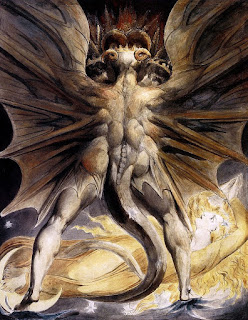Yes! A thousand times, yes!
This is the book that The Sculptor wanted
to be. It had absolutely everything the other book didn’t: Great procedural
drama, three-dimensional characters, a sympathetic villain. It restored my
faith in inhumanity after a mind-blowingly quick read.
Let me explain that last bit: I’m a notoriously slow reader,
and it usually takes me about a week to finish a book, even one that I love. I
completed this one in three days. Part of it was to get back on track to be
ahead in my work, but I couldn’t have done it if it weren’t such a compelling
read.
First, let’s clear the air about something: Hannibal Lecter
makes an appearance in this book, but if you’re looking for a Silence of the Lambs level of
participation, let me manage your expectations. He’s not really important to
the story. He’s a plot device that could easily have been replaced with any
other character. In fact, he’s not really fleshed out as the character he would
later become. But that does not mean
this book isn’t compelling or even wonderful. It’s a great read. And here’s why…
The psycho in this story is Francis Dolarhyde. Which is an
unfortunate name for somebody with a speech impediment stemming from a cleft
palate. Because he grew up in the ‘40s and ‘50s, this wasn’t something that was
easily correctable at the time and he fell victim to being an unwanted child
and ridiculed orphan. He was raised by his abusive grandmother who got her
jollies by threatening to cut off his “little buddy.” Harris does a great job
of setting Dolarhyde up as an unremorseful monster, and later breaks him down
into a sympathetic antagonist. I love stories that do this. There’s nothing
more rewarding when reading a book as rooting for both the antagonist and
protagonist. Like most psychos in literature, his trigger is the emotional
abuse he received as a child. We are introduced to him after the killings, but
are given enough background about his life and his love of The Great Red Dragon paintings by William Blake. The reader grows
with Dolarhyde as he struggles with his own transformation. He both fights it
and embraces as he begins to fall for a blind film technician. It’s a less
literal transformation as Buffalo Bill’s in Silence
of the Lambs, but the theme exists across all of Thomas’ works.
Our protagonist, Will Graham, is a tortured, yet believably
brilliant FBI special investigator (His gut isn’t a superhero, like in The Sculptor). He’s not an agent, as his
past won’t allow him to be, but he’s invaluable to the FBI as a criminal
profiler. He really knows how to get into the heads of the psychos (starting to
see why he’s not an agent?). He’s not a psycho himself, but really empathic to
their thought processes. But he’s built a life away from the Bureau, one that
he’s happy in. They suck him back in to hunt the “Tooth Fairy,” (aka, Francis
Dolarhyde, aka The Red Dragon). But what will he sacrifice? His happy life with
his wife and stepson? His life? Both? The conflict built up regarding Will
Graham’s marriage is nearly as well-written and engaging as his conflict with
the Red Dragon.
Since 1975, Thomas Harris has only written six novels, five
of which contain the Hannibal Lecter character. I say that, because reading
this book and the others, as I have over the years, you get the sense that
Thomas doesn’t necessarily relish in the story telling. He seems as tortured as
Will Graham, reluctantly returning to the word processor because he’s
encouraged to do so. That may or not be true, but like Graham, Harris is a
genius in his field and I don’t think a larger bibliography would add anything
to his mark on the art of popular fiction.


